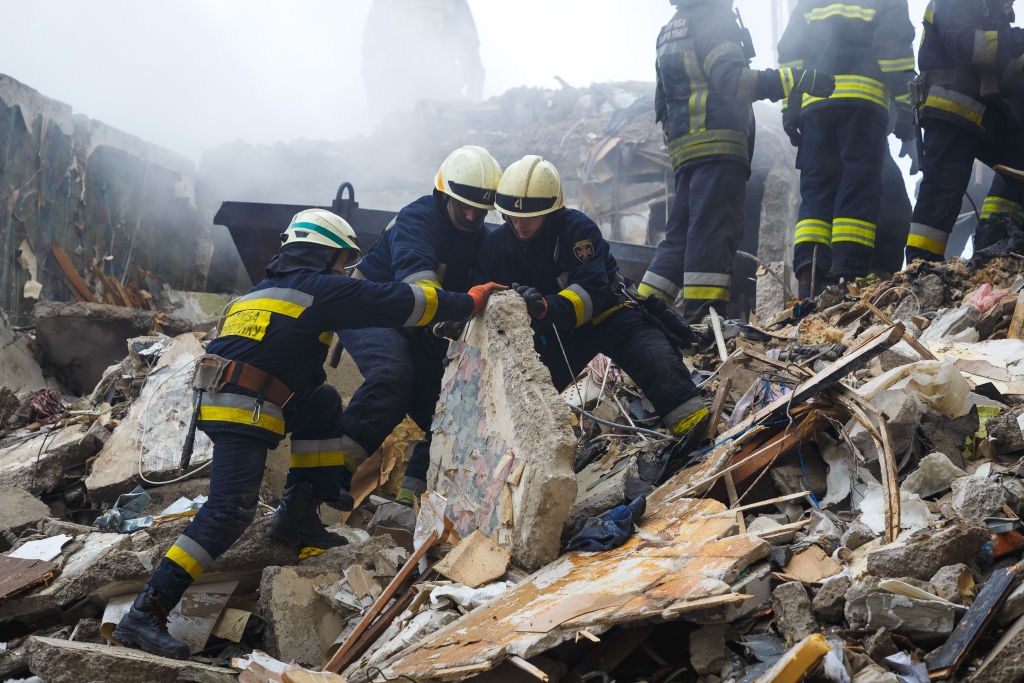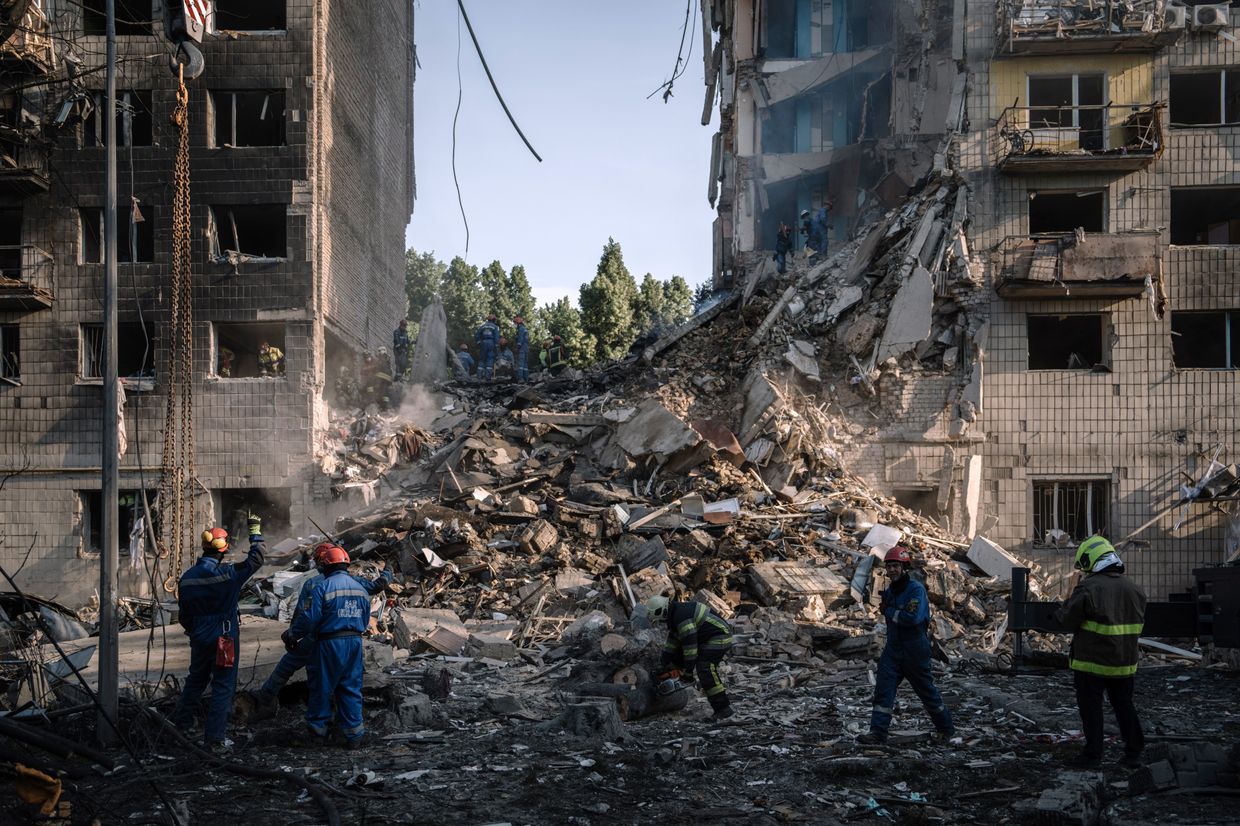Key developments on Jan. 16:
- UN: Russia's war has killed over 7,000 civilians in Ukraine since Feb. 24
- Moscow likely preparing 'decisive action' in next 6 months to 'regain initiative,' Institute for the Study of War says
- Russian, Belarusian air forces start joint military exercises along Ukrainian border
- UK announces its "most significant package of combat power to date" for Ukraine.
Two days after a Russian missile attack destroyed a section of an apartment building in Dnipro, the death toll of the strike rose to 40 people, including three children, Dnipropetrovsk Oblast Military Administration reported on Jan. 16.
At least 76 people were injured, the administration said, and 26 people are still missing as of the late evening on Jan. 16. First responders continue to work at the site.
Dnipropetrovsk Oblast Governor Valentyn Reznichenko reported earlier in the day that 14 children were among the injured.
A Russian missile hit the apartment block in a residential neighborhood in Dnipro, a city of 1 million people in central Ukraine, in the early afternoon of Jan. 14, making it one of the deadliest single attacks on civilian areas up to date since the start of Russia's full-scale invasion.
According to the Geneva Conventions, targeting residential areas constitutes a war crime.
Read more: Russian missile attack on Dnipro destroys families as death toll rises
In total, Russia's war has killed at least 7,031 civilians in Ukraine since Feb. 24, the United Nations human rights agency reported on Jan. 16, adding that at least 11,327 people were injured.
Most of the civilian casualties recorded were caused by the use of explosive weapons with wide-area effects, including shelling from heavy artillery, multiple-launch rocket systems, missiles, and air strikes.
The agency noted that the actual numbers may be significantly higher as data from areas experiencing intense hostilities or those under Russian occupation, such as Mariupol in the eastern Donetsk Oblast, or Sievierodonetsk in neighboring Luhansk Oblast, has been delayed, and numerous reports require further verification.
New Russian offensive anticipated
Although Russia has failed most of its major objectives in the war, including capturing Kyiv in the early days of the full-scale invasion and the entirety of the eastern Luhansk and Donetsk oblasts, Russian President Vladimir Putin hasn't changed his maximalist objectives to seize all of Ukraine, the Institute for the Study of War said in its latest update.
The U.S.-based think tank said that Moscow was likely aiming to "conduct a decisive action in the next six months" to regain the upper hand in Ukraine after a series of failures and successful Ukrainian counteroffensives.
The ISW suggests that the major offensive will most likely happen in the area of Luhansk Oblast, most of which is currently occupied. Meanwhile, the "most dangerous course of action" — offensive against northern Ukraine — remains "unlikely at this time," the think tank said.
Concerns about Russia attacking northern Ukraine from Belarus renewed amid the joint military exercises that the Russian and Belarusian air forces started on Jan. 16. Russia also reportedly sent 40 railroad cars with military personnel and equipment to Belarus last week.
Minsk has participated in Moscow's aggression by allowing Russia to use its territory for attacks against Ukraine. However, Belarusian troops have not been involved in invading Ukraine yet.
"These are anomalous activities that intensify the information operation that Russia will attack Ukraine from Belarus and could support an offensive," the think tank said. "Though the ISW assesses an offensive is still a low-likelihood scenario at this time."
"There continues to be no evidence that Russian forces in Belarus have created the command-and-control structures necessary for an operational strike group as of this publication."
The Ukrainian military also expects Russia to conduct a new major offensive in the east of Ukraine. General Staff Deputy Chief Oleksii Hromov said on Jan. 12 Moscow would likely try to reach the "administrative borders" of Donetsk Oblast, about half of which is currently occupied, in the near future.
Western battle tanks heading to Ukraine
Amid the threat of a new major Russian offensive, Ukraine's Western allies pledged additional military aid.
On Jan. 16, U.K. Defense Secretary Ben Wallace announced the country would hand over to Kyiv 14 Challenger 2 tanks to help push back the Russian invasion. The tanks will be supplied with armored recovery and repair vehicles.
Equipped with advanced targeting technology and armor, the Challenger 2 tank is considered to be superior to the Soviet-era tanks operated by Russian and Ukrainian forces.
Wallace also said the U.K. will deliver a battery of eight AS90 self-propelled 155 mm howitzers and two further batteries at 'varying states of readiness.'
In addition, the U.K. will donate hundreds of armored and protective vehicles, including Bulldog personnel carriers, more "uncrewed aerial systems" to support Ukrainian artillery, some 100,000 artillery rounds, hundreds of missiles, including Guided Multiple Launch Rocket System (GMLRS), Starstreak air defense, medium-range air defense missiles.
Britain will start training Ukrainian soldiers to use the Challenger 2 tanks and guns in the coming days.
Ukraine's allies must "accelerate our collective efforts to dramatically, economically, and militarily keep the pressure" on Putin, Wallace said.
Britain’s move could also heap pressure on Germany to authorize the delivery of modern German-built Leopard 2 tanks during the Rammstein defense summit on Jan. 20.
Polish President Andrzej Duda said on Jan. 11 that Poland planned to supply a company of Leopard 2 tanks to Ukraine. But since the vehicles are produced in Germany, their supply has to be approved by Berlin.
Also on Jan. 16, Polish Prime Minister Mateusz Morawiecki urged the German government to provide Ukraine with "all types of weapons."
"Ukrainians are now fighting not only for their freedom but also in defense of Europe," he said, as quoted by the Polish Press Agency.
Bloomberg reported on Jan. 13, citing two unnamed officials familiar with the matter, that Germany will likely make a decision on whether to supply Leopard tanks to Ukraine next week, ahead of the Rammstein summit.














